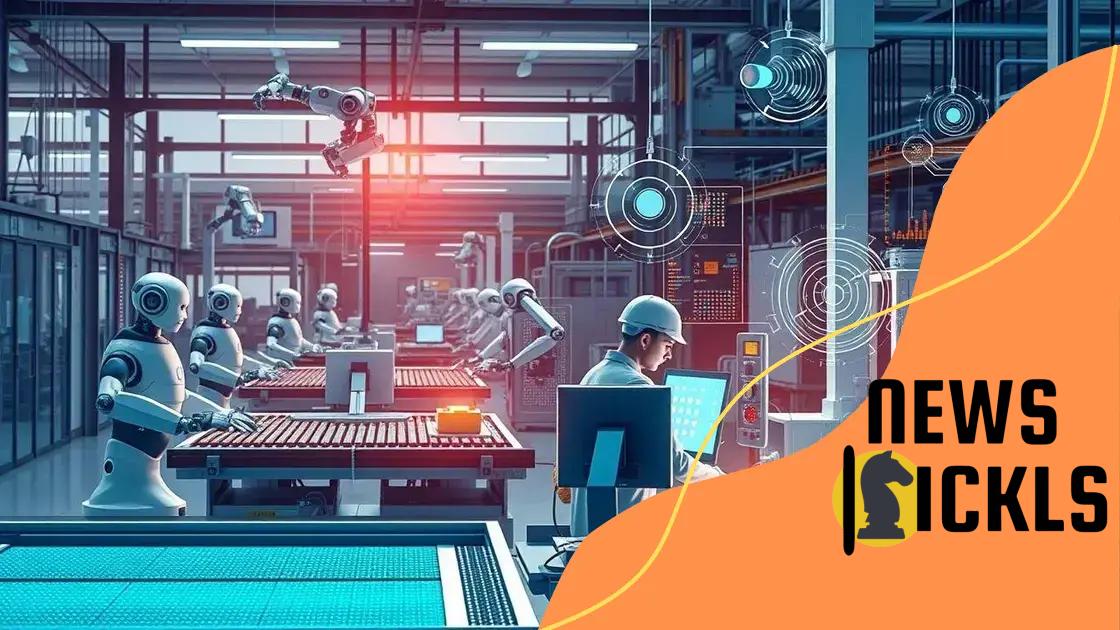The role of AI in streamlining manufacturing processes

The role of AI in streamlining manufacturing processes involves enhancing productivity, improving quality control, and reducing costs through automation, data analysis, and predictive technologies.
The role of AI in streamlining manufacturing processes is increasingly significant as companies seek greater efficiencies. Have you considered how these technologies could enhance your production line?
Understanding AI in manufacturing
AI is changing the way manufacturing works. Many businesses are now using artificial intelligence to improve their processes. This means factories are becoming more efficient and productive.
Understanding AI in manufacturing starts with recognizing its ability to analyze large amounts of data quickly. This analysis helps companies make better decisions and optimize their operations. AI can predict maintenance needs and manage inventory more effectively, translating into significant cost savings.
Key Benefits of AI in Manufacturing
AI offers several advantages for manufacturing, including:
- Improved efficiency: AI can automate repetitive tasks, freeing up human workers for more complex roles.
- Enhanced quality control: AI systems can detect defects faster and more accurately than manual processes.
- Predictive maintenance: By analyzing data from machines, AI can forecast failures before they occur, reducing downtime.
Additionally, AI can help with workforce training by providing personalized learning experiences. This allows workers to adapt to new technologies much quicker. As more companies adopt AI tools, the manufacturing landscape is shifting towards automation and smarter operations.
In conclusion, understanding AI in manufacturing is essential. The integration of artificial intelligence allows companies to boost their productivity and stay competitive in a rapidly evolving industry.
Benefits of AI for production efficiency
The benefits of AI for production efficiency are becoming increasingly clear as more factories adopt smart technologies. AI enhances the speed and accuracy of manufacturing processes in various ways.
One major advantage is the ability of AI systems to analyze vast amounts of data. This capability allows manufacturers to identify inefficiencies and optimize operations. For example, AI can monitor equipment performance in real-time, predicting when maintenance is needed to avoid costly downtime.
Key Advantages of AI in Production
Here are some of the primary benefits:
- Increased productivity: By automating routine tasks, AI frees up workers to focus on more critical activities.
- Cost reduction: Efficient processes lead to lower operational costs, directly impacting profitability.
- Enhanced flexibility: AI enables rapid adjustments to production schedules based on changing demands.
- Better quality control: AI systems can detect defects early, ensuring that only high-quality products reach the market.
Moreover, the integration of AI can help in training employees. With AI-driven training programs, workers can quickly learn new skills tailored to their specific roles. This leads to a more skilled workforce, further improving production efficiency.
As AI continues to innovate the manufacturing sector, its role in enhancing production efficiency becomes undeniable. Companies that embrace these technologies are setting themselves up for long-term success and competitiveness.
AI technologies used in manufacturing

AI technologies used in manufacturing are transforming how products are made. These innovations are streamlining processes and improving overall efficiency.
One important technology is machine learning. This allows systems to learn from data and improve decision-making over time. For example, machine learning can analyze production data to predict trends, helping manufacturers adjust their strategies accordingly.
Examples of AI Technologies
Here are some key AI technologies that are prevalent in manufacturing:
- Robotics: Automated robots are used for repetitive tasks, increasing speed and precision.
- Computer vision: This technology enables machines to inspect products in real-time, ensuring quality control.
- Natural language processing: This allows systems to understand and respond to human language, making communication with machines easier.
- Predictive analytics: By analyzing historical data, this technology forecasts potential outcomes, improving planning and resource allocation.
These AI technologies are not only enhancing productivity but also ensuring safety in the workplace. For instance, robots can take on dangerous tasks, reducing the risk of injury to human workers.
As businesses continue to explore AI options, the potential for further advancements in manufacturing remains significant. Such technologies are vital for keeping pace with the demands of today’s market.
Real-world examples of AI in factories
Real-world examples of AI in factories showcase how technology is revolutionizing manufacturing. These applications not only improve efficiency but also enhance quality and safety.
One notable example is Tesla’s use of AI for quality control in their production lines. They employ computer vision to identify defects in real-time, ensuring that only the best products are shipped to customers. This system helps reduce waste by catching issues early in the manufacturing process.
Other Noteworthy Implementations
Several companies are leading the way in integrating AI:
- Siemens: They utilize AI for predictive maintenance, allowing machines to alert operators before potential failures occur. This proactive approach minimizes downtime and keeps production running smoothly.
- GE Appliances: This company employs AI-driven analytics to optimize supply chain management. It helps in forecasting demands accurately, improving inventory management, and ensuring timely delivery of products.
- Foxconn: Known for assembling Apple products, Foxconn integrates robots powered by AI for assembly tasks. This enhances productivity while ensuring precision.
- Boeing: Boeing uses AI to improve logistics and streamline manufacturing processes. Their AI systems analyze performance data to optimize workflows, thus enhancing overall efficiency.
These examples reflect a growing trend of using artificial intelligence to drive innovation in manufacturing. They highlight how businesses can leverage AI not just for automation, but for strategic improvements in their operations.
Challenges in adopting AI in manufacturing
Challenges in adopting AI in manufacturing can be significant, even as the benefits are clear. Companies must navigate various obstacles that can affect the integration of artificial intelligence into their operations.
One major challenge is the high cost of implementing AI systems. Setting up the necessary infrastructure and technology can demand substantial financial investment. Businesses must evaluate whether the potential return justifies these costs. Additionally, there is a need for ongoing maintenance and updates, which require further financial commitment.
Key Challenges to Consider
Here are some key challenges faced when adopting AI:
- Data quality: AI systems rely on accurate and well-structured data. Poor data quality can lead to unreliable results and hinder effective decision-making.
- Workforce readiness: Employees may lack the necessary skills to work with AI technologies. Training and reskilling programs are essential to prepare the workforce for AI integration.
- Integration with existing systems: Many factories have legacy systems in place. Integrating AI with these older systems can prove to be difficult and time-consuming.
- Resistance to change: Employees and management may resist new technologies due to fear of job loss or uncertainty about new processes. Overcoming this resistance is crucial for successful implementation.
Realizing the full potential of AI requires addressing these challenges head-on. Manufacturers must adopt change management strategies to enable a smoother transition to AI-integrated operations, ensuring that the workforce is both prepared and engaged.
FAQ – Frequently Asked Questions About AI in Manufacturing
What are the main benefits of using AI in manufacturing?
AI enhances productivity, improves product quality, and reduces operational costs by automating tasks and analyzing data.
What challenges do companies face when adopting AI?
Companies often encounter high implementation costs, data quality issues, and the need for workforce training.
How can employee training improve AI adoption?
Training prepares employees to effectively use AI technologies, ensuring smoother integration and maximizing benefits.
What AI technologies are commonly used in factories?
Common technologies include machine learning, robotics, computer vision, and predictive analytics, all aimed at optimizing manufacturing processes.






